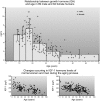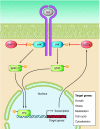Somatotropic signaling: trade-offs between growth, reproductive development, and longevity
- PMID: 23589828
- PMCID: PMC3768106
- DOI: 10.1152/physrev.00006.2012
Somatotropic signaling: trade-offs between growth, reproductive development, and longevity
Abstract
Growth hormone (GH) is a key determinant of postnatal growth and plays an important role in the control of metabolism and body composition. Surprisingly, deficiency in GH signaling delays aging and remarkably extends longevity in laboratory mice. In GH-deficient and GH-resistant animals, the "healthspan" is also extended with delays in cognitive decline and in the onset of age-related disease. The role of hormones homologous to insulin-like growth factor (IGF, an important mediator of GH actions) in the control of aging and lifespan is evolutionarily conserved from worms to mammals with some homologies extending to unicellular yeast. The combination of reduced GH, IGF-I, and insulin signaling likely contributes to extended longevity in GH or GH receptor-deficient organisms. Diminutive body size and reduced fecundity of GH-deficient and GH-resistant mice can be viewed as trade-offs for extended longevity. Mechanisms responsible for delayed aging of GH-related mutants include enhanced stress resistance and xenobiotic metabolism, reduced inflammation, improved insulin signaling, and various metabolic adjustments. Pathological excess of GH reduces life expectancy in men as well as in mice, and GH resistance or deficiency provides protection from major age-related diseases, including diabetes and cancer, in both species. However, there is yet no evidence of increased longevity in GH-resistant or GH-deficient humans, possibly due to non-age-related deaths. Results obtained in GH-related mutant mice provide striking examples of mutations of a single gene delaying aging, reducing age-related disease, and extending lifespan in a mammal and providing novel experimental systems for the study of mechanisms of aging.
Figures





References
-
- Aguirre V, Werner ED, Giraud J, Lee YH, Shoelson SE, White MF. Phosphorylation of Ser307 in insulin receptor substrate-1 blocks interactions with the insulin receptor and inhibits insulin action. J Biol Chem 277: 1531–1537, 2002 - PubMed
-
- Al-Regaiey KA, Masternak MM, Bonkowski M, Sun L, Bartke A. Long-lived growth hormone receptor knockout mice: interaction of reduced insulin-like growth factor I/insulin signaling and caloric restriction. Endocrinology 146: 851–860, 2005 - PubMed
-
- Al-Regaiey KA, Masternak MM, Bonkowski MS, Panici JA, Kopchick JJ, Bartke A. Effects of caloric restriction and growth hormone resistance on insulin-related intermediates in the skeletal muscle. J Gerontol A Biol Sci Med Sci 62: 18–26, 2007 - PubMed
-
- Alcantara MR, Salvatori R, Alcantara PR, Nobrega LM, Campos VS, Oliveira EC, Oliveira MH, Souza AH, Aguiar-Oliveira MH. Thyroid morphology and function in adults with untreated isolated growth hormone deficiency. J Clin Endocrinol Metab 91: 860–864, 2006 - PubMed
Publication types
MeSH terms
Substances
Grants and funding
LinkOut - more resources
Full Text Sources
Other Literature Sources

